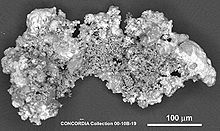Micrometeorite

Micrometerorite collected from the antarctic snow.
|
A micrometeorite is an extraterrestrial particle, ranging in size from 50 µm to 2 mm, collected on the Earth's surface. Micrometeorites are micrometeoroids which have survived entry through the Earth's atmosphere. They differ from meteorites in being smaller, more plentiful and different in composition and are a subset of cosmic dust, which also includes the smaller interplanetary dust particles (IDPs). Micrometeorites enter the Earth's atmosphere with high velocities (at least 11 km/s) and undergo heating through atmospheric friction and compression. Individual micrometeorites weigh between 10−9 and 10−4 g and collectively contribute most of the extraterrestrial material that has come to the present day Earth.Fred Lawrence Whipple first coined the term "micro-meteorite" to describe dust-sized objects that fall to the Earth. Sometimes meteoroids and micrometeoroids entering the Earth's atmosphere are visible as meteors or "shooting stars", whether or not they reach the ground and survive as meteorites and micrometorites.
Micrometeorite (MM) textures vary as their original structural and mineral compositions are modified by the degree of heating that they experience entering the atmosphere—a function of their initial speed and angle of entry. They range from unmelted particles that retain their original mineralogy (Fig. 1 a, b), to partially melted particles (Fig. 1 c, d) to round melted cosmic spherules (Fig. 1 e, f, g, h, Fig. 2) some of which have lost a large portion of their mass through vaporization (Fig. 1 i). Classification is based on composition and degree of heating.
The extraterrestrial origins of micrometeorites are determined by microanalyses that show that:
An estimated 30,000 ± 20,000 tonnes per year (t/yr) of cosmic dust enters the upper atmosphere each year of which less than 10% (2700 ± 1400 t/yr) is estimated to reach the surface as particles. Therefore, the mass of micrometeorites deposited is roughly 50 times higher than that estimated for meteorites, which represent approximately 50 t/yr, and the huge number of particles entering the atmosphere each year (~1017 > 10 µm) suggests that large MM collections contain particles from all dust producing objects in the Solar System including asteroids, comets, and fragments from our Moon and Mars. Large MM collections provide information on the size, composition, atmospheric heating effects and types of materials accreting on Earth while detailed studies of individual MMs give insights into their origin, the nature of the carbon, amino acids and pre-solar grains they contain.
...
Wikipedia
